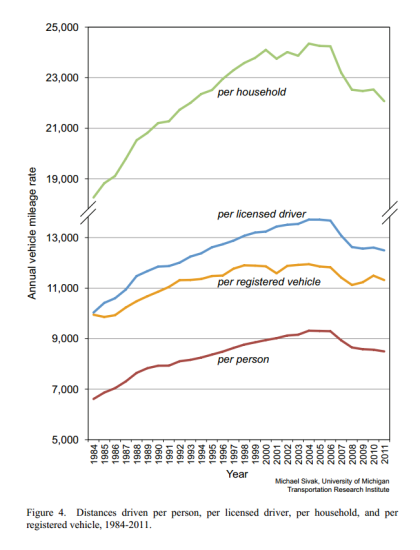Interesting. Michael Sivak, a researcher at the University of Michigan’s Transportation Research Institute, asks: “Has Motorization in the US Peaked?” His conclusion: quite possibly so. A peak looks especially evident if you look at driving rates for the US light-duty vehicle fleet—which, by whatever measure you consider, all peaked in 2004, well before the onset of the 2008 recession:
 According to Sivak, most previous looks at the issue of “peak VMT” have focused on total VMT, including long-haul trucks. Once you remove long-haul trucks, he says:
According to Sivak, most previous looks at the issue of “peak VMT” have focused on total VMT, including long-haul trucks. Once you remove long-haul trucks, he says:
[T]he combined evidence…indicates that—per person, per driver, and per household—we now have fewer light-duty vehicles and we drive each of them less than a decade ago…
These reductions likely reflect, in part, noneconomic changes in society that influence the need for vehicles (e.g., increased telecommuting, increased use of public transportation, increased urbanization of the population, and changes in the age composition of drivers). Because the onset of the reductions in the driving rates was not the result of short-term, economic changes, the 2004 maxima in the distance-driven rates have a reasonable chance of being long-term peaks as well.
An important caveat to all of this is that per capita reductions in driving don’t necessarily lead to overall reductions. As population grows, total driving could grow as well, even if per-capita rates continue their gradual decline.
That said, the vehicle travel data in recent years has clearly defied the confident predictions—some of them made quite recently—that driving rates would increase, inevitably and inexorably.








Alan
I think removing trucks gives insight but also overlooks some things. The leveling out in these indices starts before the Great Recession. One factor not mentioned In this summary that may or may not be in the full report is the significant effect of Internet commerce. Pre-2004 how much delivery occurred at your house fulfilling online orders? Today? Many people have handed off their errand driving to FedEx and our friends in Brown.
We need to be aware when we shift out consumption to others and still take responsibility. Like when folks freak about ‘China’s’ skyrocketing fossil fuel consumption without acknowledging it was largely burned to satisfy First World appetites.
That said, I know many young people who don’t want a car, including my own adult children. Ordering things online for delivery is just one way they obviate the need for one.
Clark Williams-Derry
Very good points all around. I don’t know if it’s accurate, but I’ve read reports suggesting that home delivery services reduce overall driving by 85% or more. See, e.g., http://dc.streetsblog.org/2013/05/10/how-green-is-grocery-delivery-in-cities/
But I think the bigger point about exporting manufacturing GHGs is hugely important!
William Frisinger
The data is misleading. It implies that vehicle use is dropping and it started well before the 2008 recession.
The data shows a leveling off before the recession but not a drop significantly before the recession.
Limiting the data to only the light duty vehicle fleet is misleading because I have to compete with all vehicles on the road.
Looking at the usage per person or per vehicle overlooks the population changes. In most areas with significant congestion,the population is increasing significantly.
The real curve to look at is the total vehicle miles per year in the congested metropolitan areas of the country.
That is the curve that will tell you whether we need more roads or not. Or perhaps more buses but at any rate more money into transportation.
Clark Williams-Derry
I don’t agree that the data is misleading. It tells us something, but perhaps not what you personally want to know.
Sivak does point out, as did I, that declining per capita driving may mean flat-lining–or even increasing–total traffic.
That said, the INRIX transportation scorecard shows that traffic congestion declined steadily from 2010 through 2012. We’re up a bit in 2013, but as a nation we’re less congested than we were 3 years ago. Federal data shows a flatlining of total traffic since the economic collapse in 2008, and state data for Washington and Oregon shows more than a decade of flat-lining traffic on state roads (though some of that has been because of near-saturation of major traffic routes.)